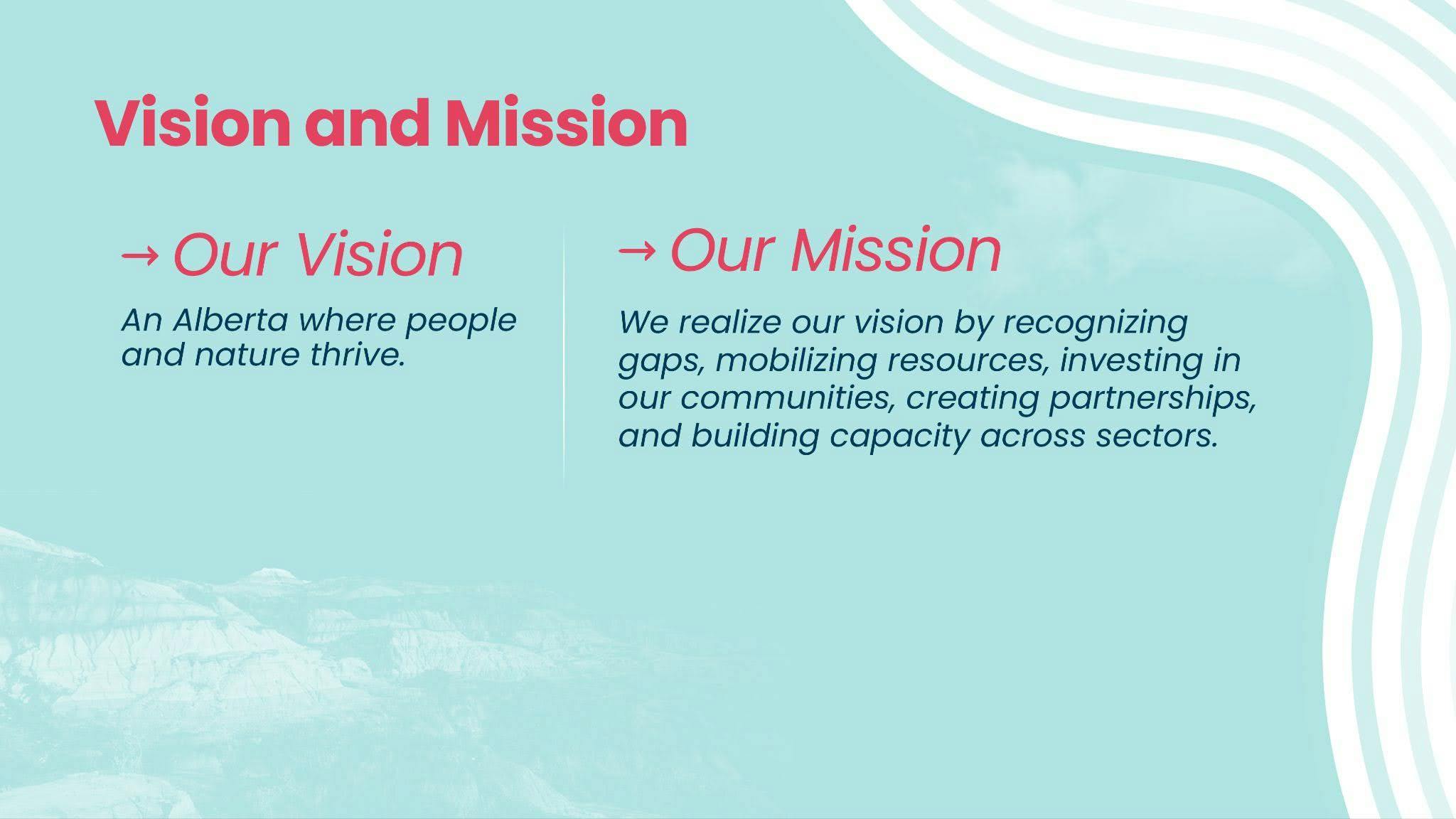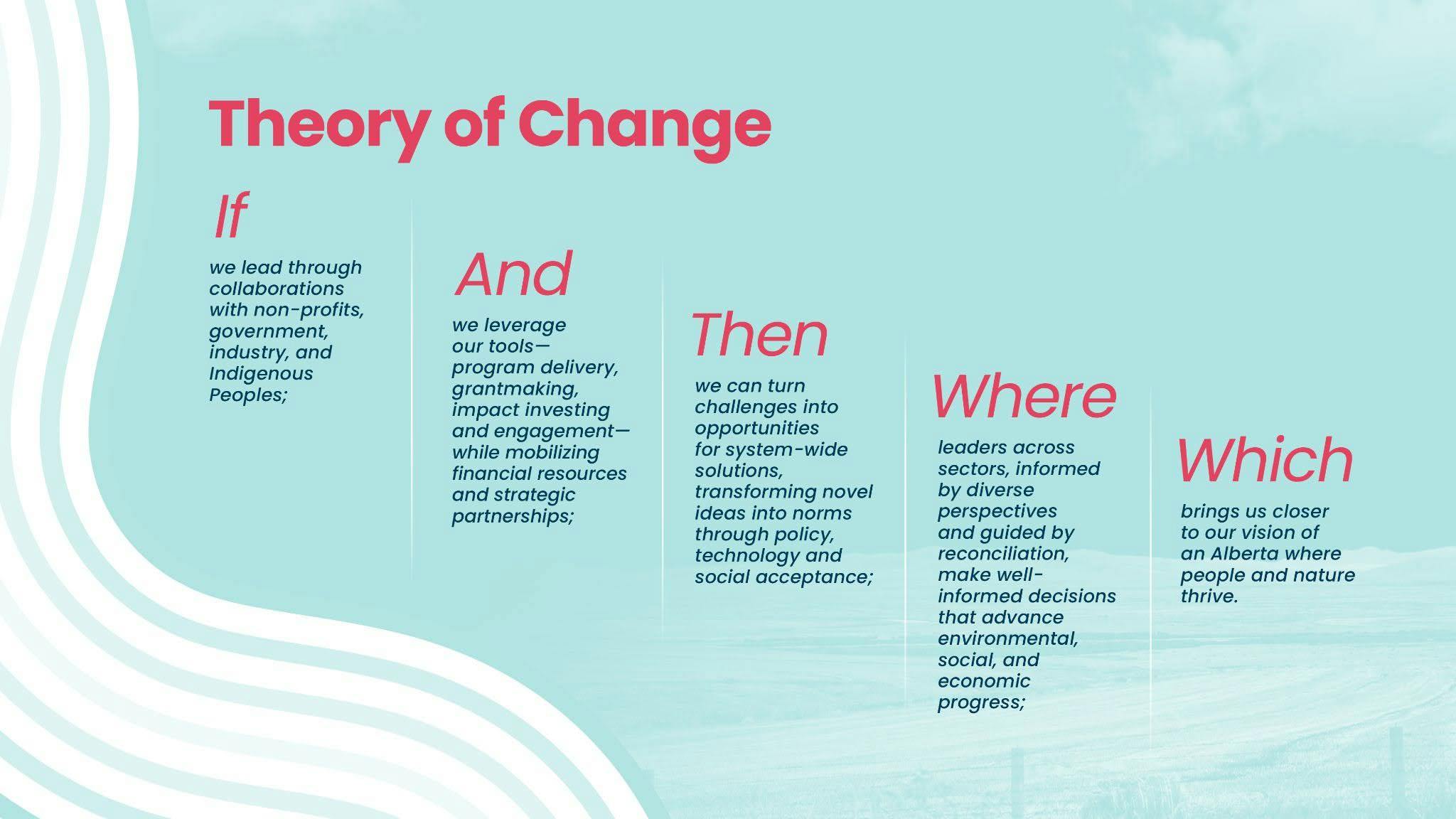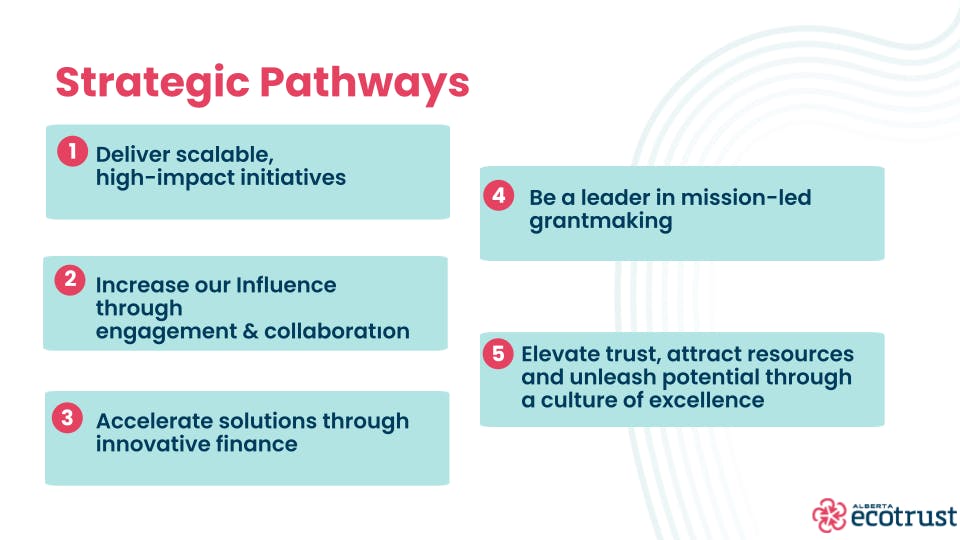Navigating the future: Alberta Ecotrust's new vision, mission and five-year strategic pathways

Having a clear direction and strategic vision is crucial for any organization, let alone one like Alberta Ecotrust, which serves as an instrument of systems change in Alberta. This is why we have spent the last year working with our board and staff to solidify our overall approach and establish new strategic directions for our organization. The result of this work is captured in our Strategic Pathways 2025- 2030, which serves as our guiding compass for navigating a landscape of environmental and climate challenges and opportunities, ensuring impactful action for the next five years.
The refreshed strategic approach brings greater alignment and focus as Alberta Ecotrust continues to evolve. Over the past five years, we have scaled significantly to meet the needs of Alberta’s ecosystems. In response, we established a new vision and mission, clarified our theory of change, and aligned our core values, focus areas and strategic objectives. The plan is rooted in five strategic pathways that signal to the community (and ourselves) the directions we are taking to move closer to our shared goals.
Vision and Mission
Alberta Ecotrust's new vision, "an Alberta where people and nature thrive," represents a strategic evolution toward a more integrated and holistic approach to our work. We have intentionally included a reference to people to better reflect the work we do in Alberta’s urban spaces. This vision is underpinned by the understanding that human well-being and a healthy environment are intrinsically linked. Although it is iterative from Alberta Ecotrust’s last vision, it represents a deliberate shift from a traditionally siloed view of environmental protection to a more comprehensive framework that acknowledges the complex interplay between ecological, social and economic systems. The vision implicitly recognizes that lasting environmental solutions cannot be achieved in isolation but require a "multisolving" approach that generates co-benefits such as green jobs, improved public health and more resilient communities. By aiming for a reality where both people and nature flourish, we are attempting to strategically position ourselves as key facilitators of a sustainable transition that is inclusive of all.
Alberta Ecotrust's mission was also updated to reflect our new integrated approach to creating systems change while ensuring we continue to support the non-profit and charitable sectors as well as all actors in the ecosystem. The mission is to "realize our vision by recognizing gaps, mobilizing resources, investing in our communities, creating partnerships, and building capacity across sectors.” It is meant to be a statement that provides a clear and actionable roadmap to our intended outcomes with a clear intent to collaborate, partner and work together to solve complex societal challenges.
The strategic pathways are centred on three core focus areas: Nature-Based Solutions and Conservation, Climate Resilience and Emissions Reductions, and Circular Economy. These focus areas are unchanged from the work we did in 2020 and 2021 when we revisited our program framework and consulted with various interest holders. The focus areas remain relevant and connected to our body of work. What has been updated is our theory of change and the specific strategies we are going to employ to achieve meaningful impact across these focus areas.

Our Theory of Change
Alberta Ecotrust's theory of change has been built on the principle of collaborative action. By strategically identifying environmental needs and then acting as a central hub—mobilizing resources, fostering cross-sector partnerships and investing in community-led initiatives—we believe we can catalyze systemic change. This change would be unattainable by any single group acting alone. The core of this theory is that by identifying and leading through the gaps and building the capacity of diverse partners, we will create a powerful ripple effect.
This theory of change is both pragmatic and ambitious. Its strength lies in the emphasis on leverage and collaboration rather than taking isolated action. This allows us to focus on scale and turning what might be a novel approach into a community or market norm. By addressing specific "gaps," Alberta Ecotrust can create the necessary conditions for change to emerge organically from within communities and across sectors.

The Strategic Pathways: Our compass
There are five strategic pathways:
- Deliver scalable, high-impact initiatives
- Increase our influence through engagement and collaboration
- Accelerate solutions through innovative finance
- Be a leader in mission-led grantmaking
- Elevate trust, attract resources and unleash potential through a culture of excellence
The first pathway highlights the organization as it operates today, a program delivery agent that finds the gaps and leads impactful projects and initiatives. The second acknowledges that we have a voice and, through our position in the ecosystem, we can engage leaders and collaborate across sectors and world views. The third pathway is focused on our role as an impact investor, where we can de-risk and scale innovation. Impact investing is a growing strategy for us in the next five years, building on the success of our partners in the Low Carbon Cities Canada (LC3) network.
Leaning into our legacy as a grant-maker, our third strategic pathway focuses on enabling our ecosystem partners to do connected, impactful, scalable work that is aligned with our charitable objectives. Supporting a robust non-profit and charitable sector is a key strategy that Alberta Ecotrust has supported for over thirty years. And finally, we can do none of these things if we don't have a modernized organizational infrastructure and culture of excellence where our employees are valued and supported, our systems are strong, and our management is rigorous. The real impact will not be created by any singular strategic pathway, but rather by marrying all these approaches and strategic directions to keep us moving towards our objectives.
The document concludes with our commitment to measuring success (and learning from our failures) while continually improving. Our robust monitoring, evaluation, reporting and learning system includes a comprehensive results-based management system. The system measures and reports progress toward environmental outcomes, including reductions in greenhouse gas emissions and the creation of jobs. We also track how our funding is supporting Indigenous leadership and equity-deserving groups. This commitment to data-driven decision-making enhances the effectiveness of Alberta Ecotrust's initiatives and ensures our long-term sustainability.

Conclusion
We recognize that achieving lasting system change requires uniting diverse interest holders, including non-profits, government, industry and Indigenous Peoples. Building on our legacy of convening, our new strategic plan re-emphasizes the organization's role as a leader in fostering collaboration, building trust-based partnerships and advancing equity and inclusion. By working together, Alberta Ecotrust can leverage collective knowledge and resources, amplifying its impact and driving transformative change.
Although clear direction is necessary, we also acknowledge the need to incorporate flexibility to adapt to emerging environmental challenges and fluctuating economic conditions, allowing for adjustments and refinements as circumstances evolve. The Strategic Pathways strike a balance, providing room for reflection, improvement, and adaptability.
The Strategic Pathways 2025-30 document is more than just a plan; it's a critical tool that positions Alberta Ecotrust to lead and catalyze effective environmental and climate solutions in Alberta. We hope the plan will enable Alberta Ecotrust and our partners and collaborators to navigate the complexities of today's environmental challenges and create a future where people and nature thrive.
Related posts
Explore our most recent posts.



